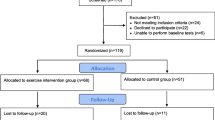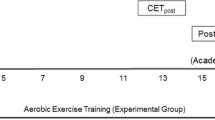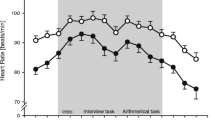Abstract
The present study experimentally tested the cross-stressor adaptation hypothesis by examining whether endurance exercise training leads to reductions in the physiological stress response to a psychosocial stressor. We randomly assigned 149 healthy men to a 12-week exercise training, relaxation training, or a wait list control group. Before and after intervention we assessed the groups’ physical fitness (lactate testing) and compared their physiological stress responses to the Trier Social Stress Test for Groups in terms of salivary free cortisol, heart rate (HR) and heart rate variability (HRV); the final sample consisted of 96 subjects. As hypothesized, the exercise training significantly improved fitness and reduced stress reactivity in all three parameters; however, it only improved stress recovery in terms of HR. The relaxation program reduced only cortisol, but not HR or HRV reactivity; no changes emerged for the control group. The findings suggest that the cross-stressor adaptation hypothesis is valid for cardiovascular as well as endocrine stress reactivity.



Similar content being viewed by others
Notes
It must be noted that these exclusions might cause our analyses to become less conservative (Gupta, 2011).
Different committees judged the subjects at T1 and T2 while judging the same number of subjects at T1 and T2.
We preferred the AUC G to the AUC with respect to increase (AUC I ), as we were interested in the total amount of the response (Federenko et al., 2004). Furthermore, the AUC I is based on the reference to the first value allowing for negative results in the case of a decrease (Pruessner et al., 2003).
A baseline reduction already implies absolute changes in stress reactivity. If the baseline value is taken into account, relative changes are examined. As regular exercise is not known to generally reduce the cortisol level (Duclos & Tabarin, 2011), there was no need to assess the relative change in stress reactivity for cortisol.
References
Albright, C., King, A., Taylor, C., & Haskell, W. (1992). Effect of a six-month aerobic exercise training program on cardiovascular responsivity in healthy middle-aged adults. Journal of Psychosomatic Research, 36, 25–36. doi:10.1016/0022-3999(92)90111-E
American Psychological Association. (2013). Stress in America™. Retrieved from http://www.apa.org/news/press/releases/stress/2012/full-report.pdf
Anshel, M. H. (1996). Effect of chronic aerobic exercise and progressive relaxation on motor performance and affect following acute stress. Journal of Behavioral Medicine, 21, 186–196. doi:10.1080/08964289.1996.9933757
Blumenthal, J. A., Emery, C. F., Walsh, M. A., Cox, D. R., Kuhn, C. M., Williams, R. B., et al. (1988). Exercise training in healthy type A middle-aged men: Effects on behavioral and cardiovascular responses. Psychosomatic Medicine, 50, 418–433.
Blumenthal, J. A., Fredrikson, M., Kuhn, C. M., Ulmer, R. L., Walsh-Riddle, M., & Appelbaum, M. (1990). Aerobic exercise reduces levels of cardiovascular and sympathoadrenal responses to mental stress in subjects without prior evidence of myocardial ischemia. American Journal of Cardiology, 65, 93–98.
Blumenthal, J. A., Fredrikson, M., Matthews, K. A., Kuhn, C. M., Schniebolk, S., German, D., et al. (1991). Stress reactivity and exercise training in premenopausal and postmenopausal women. Health Psychology, 10, 384–391.
Calvo, M. G., Szabo, A., & Capafons, J. (1996). Anxiety and heart rate under psychological stress: The effects of exercise-training. Anxiety, Stress and Coping, 9, 321–337.
Carroll, D., Phillips, A. C., & Der, G. (2008). Body Mass Index, abdominal adiposity, obesity, and cardiovascular reactions to psychological stress in a large community sample. Psychosomatic Medicine, 70, 653–660. doi:10.1097/PSY.0b013e31817b9382
Carter, J. B., Banister, E. W., & Blaber, A. P. (2003). Effect of endurance exercise on autonomic control of heart rate. Sports Medicine, 33, 33–46.
Chida, Y., & Steptoe, A. (2010). Greater cardiovascular responses to laboratory mental stress are associated with poor subsequent cardiovascular risk status: A meta-analysis of prospective evidence. Hypertension, 55, 1026–1032.
Chrousos, G. P. (2009). Stress and disorders of the stress system. Nature Reviews Endocrinology, 5, 374–381. doi:10.1038/nrendo.2009.106
de Geus, E. J., & Stubbe, J. H. (2007). Aerobic exercise and stress reduction. In G. Fink (Ed.), Encyclopedia of stress (pp. 73–78). New York: Academic Press.
de Geus, E. J., van Doornen, L. J., de Visser, D. C., & Orlebeke, J. F. (1990). Existing and training induced differences in aerobic fitness: Their relationship to physiological response patterns during different types of stress. Psychophysiology, 27, 457–478.
Dickerson, S., & Kemeny, M. (2004). Acute stressors and cortisol responses: A theoretical integration and synthesis of laboratory research. Psychological Bulletin, 130, 355–391. doi:10.1037/0033-2909.130.3.355
Duclos, M., & Tabarin, A. (2011). Exercise, training, and the hypothalamo–pituitary–adrenal axis. In E. Ghigo, F. Lanfranco, & C. J. Strasburger (Eds.), Endocrine updates (Vol. 29, pp. 9–15). Boston, MA: Springer.
Federenko, I. S., Nagamine, M., Hellhammer, D. H., Wadhwa, P. D., & Wüst, S. (2004). The heritability of hypothalamus pituitary adrenal axis responses to psychosocial stress is context dependent. Journal of Clinical Endocrinology and Metabolism, 89, 6244–6250. doi:10.1210/jc.2004-0981
Foley, P., & Kirschbaum, C. (2010). Human hypothalamus–pituitary–adrenal axis responses to acute psychosocial stress in laboratory settings. Neuroscience and Biobehavioral Reviews, 35, 91–96. doi:10.1016/j.neubiorev.2010.01.010
Forcier, K., Stroud, L. R., Papandonatos, G. D., Hitsman, B., Reiches, M., Krishnamoorthy, J., et al. (2006). Links between physical fitness and cardiovascular reactivity and recovery to psychological stressors: A meta-analysis. Health Psychology, 25, 723–739. doi:10.1037/0278-6133.25.6.723
Fuchs, R. (2012). Messung der Bewegungs- und Sportaktivität: Der BSA-Fragebogen. [Measurement of daily activities and exercise questionnaire]. http://www.sport.uni-freiburg.de/institut/Arbeitsbereiche/psychologie
Gaab, J., Rohleder, N., Nater, U. M., & Ehlert, U. (2005). Psychological determinants of the cortisol stress response: The role of anticipatory cognitive appraisal. Psychoneuroendocrinology, 30, 599–610. doi:10.1016/j.psyneuen.2005.02.001
Georgiades, A., Sherwood, A., Gullette, E. C., Babyak, M. A., Hinderliter, A., Waugh, R., et al. (2000). Effects of exercise and weight loss on mental stress-induced cardiovascular responses in individuals with high blood pressure. Hypertension, 36, 171–176.
Gerber, M. (2008). Sportliche Aktivität und Stressreaktivität: Ein Review [Physical exercise and stress reactivity: A review]. Deutsche Zeitschrift für Sportmedizin, 59, 168–174.
Gupta, S. K. (2011). Intention-to-treat concept: A review. Perspectives in Clinical Research, 2, 109–112. doi:10.4103/2229-3485.83221
Jackson, E., & Dishman, R. (2006). Cardiorespiratory fitness and laboratory stress: A meta-regression analysis. Psychophysiology, 43, 57–72. doi:10.1111/j.1469-8986.2006.00373.x
Janssen, P. (2001). Lactate threshold training. Champaign, IL: Human Kinetics.
Karmakar, C. K., Khandoker, A. H., Voss, A., & Palaniswami, M. (2011). Sensitivity of temporal heart rate variability in Poincare plot to changes in parasympathetic nervous system activity. Biomedical Engineering Online, 10, 17. doi:10.1186/1475-925X-10-17
Keller, S., & Seraganian, P. (1984). Physical fitness level and autonomic reactivity to psychosocial stress. Journal of Psychosomatic Research, 28, 279–287.
Kindermann, W., Schramm, M., & Keul, J. (1980). Aerobic performance diagnostics with different experimental settings. International Journal of Sports Medicine, 1, 110–114.
King, A. C., Baumann, K., O’Sullivan, P., Wilcox, S., & Castro, C. (2002). Effects of moderate-intensity exercise on physiological, behavioral, and emotional responses to family caregiving: A randomized controlled trial. Journal of Gerontology: Medical Sciences, 57, 26–36. doi:10.1093/gerona/57.1.M26
Kirschbaum, C., Pirke, K. M., & Hellhammer, D. H. (1993). The “Trier Social Stress Test”—A tool for investigating psychobiological stress responses in a laboratory setting. Neuropsychobiology, 28, 76–81.
Klaperski, S., von Dawans, B., Heinrichs, M., & Fuchs, R. (2013). Does the level of physical exercise affect physiological and psychological responses to psychosocial stress in women? Psychology of Sport and Exercise, 14, 266–274. doi:10.1016/j.psychsport.2012.11.003
Kubitz, K. A., & Landers, D. M. (1993). The effects of aerobic training on cardiovascular responses to mental stress: An examination of underlying mechanisms. Journal of Sport & Exercise Psychology, 15, 326–337.
Laux, L., Glanzmann, P., Schaffner, P., & Spielberger, C. D. (1981). STAI. State-Trait-Angstinventar [STAI. State-trait anxiety inventory]. Göttingen: Beltz Test GmbH.
Linden, W., Earle, T. L., Gerin, W., & Christenfeld, N. (1997). Physiological stress reactivity and recovery: Conceptual siblings separated at birth? Journal of Psychosomatic Research, 42, 117–135. doi:10.1016/S0022-3999(96)00240-1
Pruessner, J., Kirschbaum, C., Meinlschmid, G., & Hellhammer, D. (2003). Two formulas for computation of the area under the curve represent measures of total hormone concentration versus time-dependent change. Psychoneuroendocrinology, 28, 916–931.
Raglin, J., & Wilson, G. (2012). Exercise and its effects on mental health. In C. Bouchard, S. Blair, & W. Haskell (Eds.), Physical activity and health (pp. 331–342). Leeds: HK.
Rimmele, U., Seiler, R., Marti, B., Wirtz, P. H., Ehlert, U., & Heinrichs, M. (2009). The level of physical activity affects adrenal and cardiovascular reactivity to psychosocial stress. Psychoneuroendocrinology, 34, 190–198. doi:10.1016/j.psyneuen.2008.08.023
Rimmele, U., Zellweger, B. C., Marti, B., Seiler, R., Mohiyeddini, C., Ehlert, U., et al. (2007). Trained men show lower cortisol, heart rate and psychological responses to psychosocial stress compared with untrained men. Psychoneuroendocrinology, 32, 627–635. doi:10.1016/j.psyneuen.2007.04.005
Roecker, K., Schotte, O., Niess, A. M., Horstmann, T., & Dickhuth, H. H. (1998). Predicting competition performance in long-distance running by means of a treadmill test. Medicine and Science in Sports and Exercise, 30, 1552–1557.
Schulz, P., Schlotz, W., & Becker, P. (2004). Trierer Inventar zum chronischen Stress: TICS [The Trier Inventory For Chronic Stress: TICS]. Göttingen: Hogrefe.
Sherwood, A., Light, K. C., & Blumenthal, J. A. (1989). Effects of aerobic exercise training on hemodynamic responses during psychosocial stress in normotensive and borderline hypertensive type A men: A preliminary report. Psychosomatic Medicine, 51, 123–136.
Sinyor, D., Golden, M., Steinert, Y., & Seraganian, P. (1986). Experimental manipulation of aerobic fitness and the response to psychosocial stress: Heart rate and self-report measures. Psychosomatic Medicine, 48, 324–337.
Smith, J. C. (1999). ABC relaxation training. New York: Springer.
Sothmann, M. S. (2006). The cross-stressor adaptation hypothesis and exercise training. In E. O. Acevedo & P. Ekkekakis (Eds.), Psychobiology of physical activity (pp. 149–160). Champaign, IL: Human Kinetics.
Spalding, T. W., Jeffers, L. S., Porges, S. W., & Hatfield, B. D. (2000). Vagal and cardiac reactivity to psychological stressors in trained and untrained men. Medicine and Science in Sports and Exercise, 32, 581–591.
Spalding, T. W., Lyon, L. A., Steel, D. H., & Hatfield, B. D. (2004). Aerobic exercise training and cardiovascular reactivity to psychological stress in sedentary young normotensive men and women. Psychophysiology, 41, 552–562. doi:10.1111/j.1469-8986.2004.00184.x
Stein, P. K., & Boutcher, S. H. (1992). The effect of participation in an exercise training program on cardiovascular reactivity in sedentary middle-aged males. International Journal of Psychophysiology, 13, 215–223.
Steptoe, A., Moses, J., Mathews, A., & Edwards, S. (1990). Aerobic fitness, physical activity, and psychophysiological reactions to mental tasks. Psychophysiology, 27, 264–274.
Throne, L. C., Bartholomew, J. B., Craig, J., & Farrar, R. P. (2000). Stress reactivity in fire fighters: An exercise intervention. International Journal of Stress Management, 7, 235–246. doi:10.1023/A:1009574428627
Tulppo, M. P., Makikallio, T. H., Takala, T. E., Seppanen, T., & Huikuri, H. V. (1996). Quantitative beat-to-beat analysis of heart rate dynamics during exercise. American Journal of Physiology-Heart and Circulatory Physiology, 271, 244–252.
van Doornen, L. J., & de Geus, E. J. (1993). Stress, physical activity and coronary heart disease. Work & Stress, 7, 121–139. doi:10.1080/02678379308257056
von Dawans, B., Kirschbaum, C., & Heinrichs, M. (2011). The Trier Social Stress Test for Groups (TSST-G): A new research tool for controlled simultaneous social stress exposure in a group format. PNEC, 36, 514–522. doi:10.1016/j.psyneuen.2010.08.004
Warburton, D., Nicol, C., & Bredin, S. (2006). Health benefits of physical activity: The evidence. Canadian Medical Association Journal, 174, 801–809. doi:10.1503/cmaj.051351
Wasserman, K. (2011). Principles of exercise testing and interpretation (5th ed.). Philadelphia: Lippincott Williams & Wilkins.
Wittling, W., & Wittling, R. A. (2012). Herzschlagvariabilität: Frühwarnsystem, Stress- und Fitnessindikator [Heart rate variability]. Heiligenstadt: Eichsfeld Verlag.
Acknowledgments
This study was funded by the German Research Foundation (Research Grant FU458/2-1).
Conflict of interest
Authors Sandra Klaperski, Bernadette von Dawans, Markus Heinrichs, and Reinhard Fuchs declare that they have no conflict of interest.
Informed Consent
All procedures followed were in accordance with the ethical standards of the responsible committee on human experimentation (institutional and national) and with the Helsinki Declaration of 1975, as revised in 2000. Informed consent was obtained from all patients for being included in the study.
Author information
Authors and Affiliations
Corresponding author
Rights and permissions
About this article
Cite this article
Klaperski, S., von Dawans, B., Heinrichs, M. et al. Effects of a 12-week endurance training program on the physiological response to psychosocial stress in men: a randomized controlled trial. J Behav Med 37, 1118–1133 (2014). https://doi.org/10.1007/s10865-014-9562-9
Received:
Accepted:
Published:
Issue Date:
DOI: https://doi.org/10.1007/s10865-014-9562-9




